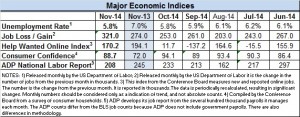 The U.S. economy delivered a powerful holiday surprise, adding 321,000 new jobs last month, the most in almost three years.
The U.S. economy delivered a powerful holiday surprise, adding 321,000 new jobs last month, the most in almost three years.
To add to the robust report, the Labor Department’s monthly employment report, out this morning, adjusted upward its initial numbers for September and October by 44,000 jobs. Together with November, the U.S. economy has averaged 241,000 new jobs each month this year. In 2013 the average for the 11 months was 204,000 and in 2012 it was 184,000.
The unemployment rate was unchanged at 5.8%. A year ago the rate was 7%.
All major sectors added jobs. Temp hiring, at 22,700 new jobs, accounted for 7.3% of the total created. Since January, agencies have averaged 18,500 new temp jobs a month. Last year, the average was 15,670.
Executive search firms added 1,400 workers to their payrolls in October, bringing the number of workers employed in the field to a historic high of 42,900. (The Labor Department reports sub-sectors, like executive search, a month behind the major industry groups. October is the most recent report.)
Other major contributors to the November total:
- Manufacturing, up 28,000 jobs;
- Retail grew by 50,200 workers, many of those jobs are likely to be seasonal. Clothing stores accounted for 11,300; auto dealers added 10,500 jobs;
- Healthcare, one of the fastest growing sectors for several years, added 37,200 jobs in November. Most of those (24,300) were in ambulatory health care.
- The hospitality industry added 32,000 jobs. Bars and restaurants, typically low wage jobs, grew by 26,500.
In another surprise, the Labor Department’s report said hourly wages increased by 9 cents, about twice the expectation. However, the year’s average wage increase of 2.1% is little changed since 2009, a special concern because slow wage growth limits spending and has the potential for slowing overall economic improvement.
Wednesday, the Federal Reserve released its periodic “Beige Book.” This compilation of informal economic conditions in each of the Fed’s 12 districts reported generally good conditions nationwide, including increases in hiring and planned hiring. Healthier consumer spending was also reported.
The Labor Department’s report said the average workweek on private, nonfarm payrolls, rose 34.6 hours. Workers in manufacturing jobs saw their workweek increase to 41.1 hours, with overtime averaging 3.5 hours.
The workweek increases, coupled with other reports showing a tightening of labor supply in the months ahead, suggest employers may finally have to begin to raise wages more rapidly. That’s been happening for some time in the high tech field and for specific types of other jobs.